World’s first 100% digitally-enabled building comes to Toronto
Toronto / Canada
〰️
Toronto / Canada 〰️
Render of the world’s first fully digitally enabled building. Image: Toronto Metropolitan University.
TL;DR: Imagine a space where every element communicates seamlessly, ensuring efficiency and sustainability like never before.
So what? You don’t just have to imagine it—soon you’ll be able to go to Toronto and visit, or check out its digital twin online.
In an era where technology and sustainability are becoming increasingly intertwined, the Smart Campus Integration and Testing (SCIT) Hub emerges as a beacon of innovation at Toronto Metropolitan University. This world-leading facility, a cornerstone of the Network of Living Campuses (NLC) initiative, represents a leap in Smart and Sustainable building research. Established in 2016, NLC brings together faculty members from eight Canadian universities, united in their vision to transform campuses into smart, sustainable environments through Building Information Modeling and Data Science.
Sustainable integration and global impact
The Hub is not just another building; it's an example of how digital innovation can reshape our physical environment. Integrating all building systems—from heating and cooling to security and—it sets a new standard for the co-optimisation of design features.
Designed by WZMH Architects, the facility doesn't just belong to Canada but to the world. The the ~300 square-metre Hub transcends geographical boundaries, and is accessible both in person and remotely through a secure digital twin, opening doors for global research collaborations that benefit people and the planet.
The SCIT Hub at Toronto Metropolitan University
Four pillars of research excellence
The facility, currently in its pre-construction phase, will focus on four key research areas:
Integrated Smart City and Campus Management: This aspect explores how the integration of various building systems like security, heating and cooling, and energy can contribute to smarter, more efficient campus and city management. It's about turning buildings into responsive, adaptive entities within larger urban ecosystems.
Smart Commissioning for Peak Performance: Here, the focus is on ensuring that building systems not only operate efficiently at the outset but continue to do so over time. It's about the long-term performance and optimisation of assets, ensuring sustainability is not just a one-time feature but a continuous process.
Advanced Energy Simulation: This line of research delves into sophisticated simulation techniques to predict and enhance building energy performance. It's an exploration into the 'what-ifs' of building design and operation, offering insights that could revolutionise energy use in buildings.
Human-Building Interaction: At the heart of it all is the human experience. This research area, perhaps the most important aspect of all, focuses on how people interact with their built environments, striving to enhance comfort and wellbeing.
The SCIT Hub will integrate all its systems digitally, in a world first.
A collaborative, innovative hub
The Smart Campus Integration and Testing Hub is a symbol of a future where buildings are dynamic, intelligent environments that contribute to a sustainable world. Its creation marks a significant step forward in smart and sustainable building research, promising a future where buildings are not only functional but are integral, responsive parts of our ever-evolving urban landscapes.



